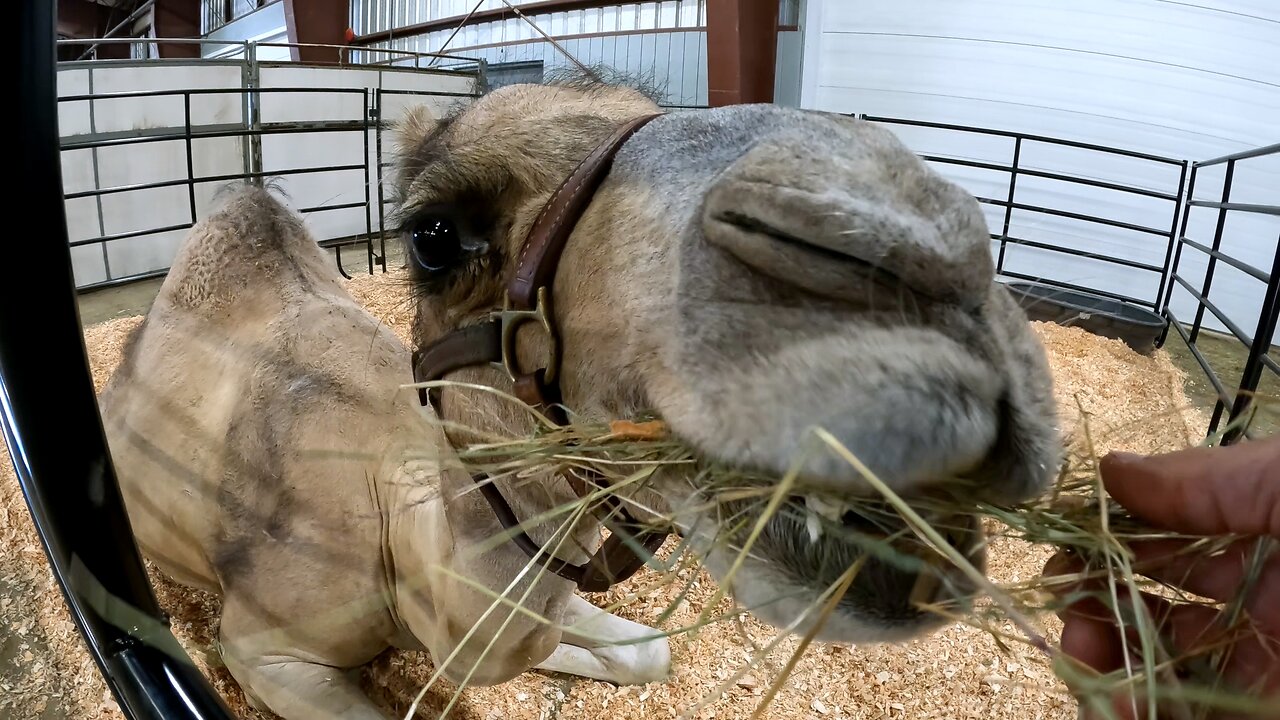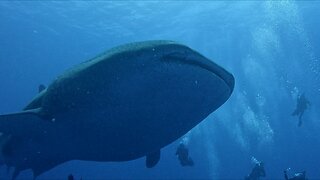Premium Only Content

Very chill camel enjoys a tasty snack
This camel is completely relaxed as he spends the day at a fair in Chilliwack, British Columbia. He's very comfortable with people and he happily allows anyone to pet him and scratch his ears. He'll also happily take a handful of fresh, green hay. He munches contentedly as the people passing by stop to get a close look.
Camels are sturdy mammals known for their distinctive physical characteristics, which enable them to thrive in harsh desert environments.
Camels are large, with adult camels standing about 6 to 7 feet (1.8 to 2.1 meters) tall at the shoulder. They can weigh between 880 to 1,320 pounds (400 to 600 kg).
One of the most distinguishing features is the hump on their back. There are two main species of camels. A dromedary (Arabian) Camel has one hump. A Bactrian camel has two humps. A camel's humps store fat, which can be converted into energy and water when food is scarce.
Camels have large, tough mouths that are well-suited for eating thorny desert vegetation. They have slit-like nostrils that can close to protect against sand and dust. Their eyes are large, with long eyelashes that help keep sand out, and a third eyelid (nictitating membrane) that provides additional protection. Camels have long, powerful legs, which help them walk long distances and carry heavy loads. Their broad, flat feet are specially adapted for walking on sand, with tough, leathery pads that prevent sinking. Camels have thick fur that helps insulate them from both the heat and cold. In the summer, they shed much of this fur to keep cool.
Their coat color ranges from light brown to beige, providing natural camouflage in desert environments. Camels are highly adapted to conserve water. They can drink large amounts of water quickly (up to 40 gallons in one go) and can survive for long periods without drinking.
Camels can tolerate body temperature fluctuations that would be fatal to most other animals, which helps them avoid sweating and thus conserve water.
These characteristics make camels well-suited to life in arid and semi-arid regions, where they have been used by humans for transportation, food, and other resources for thousands of years.
-
 1:33
1:33
WildCreatures
1 month ago $0.41 earnedGigantic whale shark makes scuba divers look like tiny tadpoles
2.5K5 -
 1:14:05
1:14:05
DeVory Darkins
15 hours agoDemocrats get BAD EPSTEIN NEWS after major mistake
153K131 -
 2:29:10
2:29:10
Badlands Media
9 hours agoDevolution Power Hour Ep. 406: Cracks in the Empire
235K22 -
 2:55:16
2:55:16
TimcastIRL
8 hours agoNEW Epstein Emails Drop, Dems Claim TRUMP KNEW, Congress Forces Epstein Release Vote | Timcast IRL
252K108 -
 1:19:53
1:19:53
Barry Cunningham
6 hours agoBREAKING NEWS: PRESIDENT TRUMP RE-OPENS THE UNITED STATES GOVERNMENT!
42.1K18 -
 20:47
20:47
The White House
7 hours agoPresident Trump Signs Senate Amendment to H.R. 5371
34.2K33 -
 4:37:57
4:37:57
Drew Hernandez
23 hours agoNEW EPSTEIN EMAIL DROP FULLY POLITICIZED
59.4K19 -
 1:44:01
1:44:01
Tucker Carlson
6 hours agoTucker Carlson on the Israel First Meltdown and the Future of the America First Movement
65.9K419 -
 4:02:08
4:02:08
Alex Zedra
6 hours agoLIVE! Phasmaphobia New Map!
55.4K2 -
 2:16:06
2:16:06
Laura Loomer
8 hours agoEP155: Jihad Makes Its Move On The White House
47.3K62